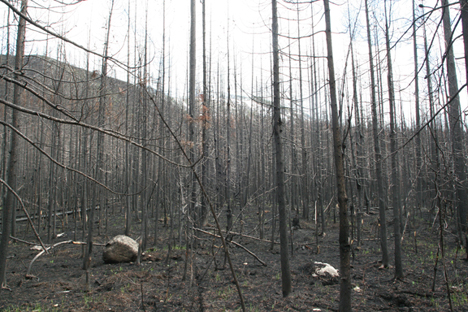Forest Service suppression tactics don’t meet muster
by Charley Fitch, Speak Your Piece, Redding Record Searchlight, December 7, 2008 [here]
The Concerned Citizens for Reasonable Fire Management, consisting of Forest Service retirees, foresters, Trinity County citizens and business owners, have been studying the 1999, 2006 and 2008 fires on the Big Bar Ranger District. We believe that we see a pattern that is most disturbing. Since 1999 over 300,000 acres of the district, in northwestern Trinity County, have been burned. From the 1905 inception of the Forest Service until 1999 — 93 years — less than 100,000 acres. Maybe a result of global warming or drought — we don’t believe so! We have the rain records to prove it.
The recent Fire Forum was definitely a step in the right direction. When studying fire suppression covering all of Northern California, involving multiple fire agencies with different suppression responsibilities, it is unlikely that any clear solution could evolve. However, our group has concentrated on only the Big Bar Ranger District of the Shasta-Trinity National Forest. Here we have been able to isolate some issues and have narrowed the focus.
Why such a dramatic rise in fire size and duration? Our analysis leads us to the following reasons. Forests are creating more woody volume each year. In fact the Shasta-Trinity as of the early 1990s was growing 400 million board feet each year. Now with the current environmental protections in place, the Shasta-Trinity is removing less than 50 million board feet annually. So each year the forest builds up more fuel in the forest. Of course we can just watch it grow and then let it burn. That seems to be the opinion of many people who call themselves environmentalists. Or we allow removal of reasonable amounts of timber that can be used to build houses, offset some of the lumber imports into this country and reduce the fuel loading in the forests. Tough choice?
One very important facet of this very complicated issue that was not brought out in the write-up of the forum is a change in suppression tactics used by federal fire managers. This seems to be one issue that nobody wants to bring out in the open. The federal fire agencies have at least in behavior if not in written policy altered their suppression tactics. The underlying issue is safety. Firefighting tactics long accepted as effective and safe are now shunned by fire managers.
2007 Fire Season Federal forest policy The 2008 Fire Season
by admin
leave a comment
The Draft 2009 Quadrennial Fire Review
The National Wildfire Coordinating Group (NWCG) has prepared a draft 2009 Quadrennial Fire Review (QFR). The NWCG is made up of representatives of the U.S. Forest Service and the four U. S. Department of Interior agencies that constitute the federal wildland fire bureaucracy. The 2009 QFR, like its predecessor, the 2005 QFR, is “a strategic evaluative process that develops an internal assessment of current programs and capabilities for comparison to future needs for fire management.”
The draft 2009 QFR has been made available through the International Association of Fire Chiefs [here].
In the draft, facilitator Dr. Al Hyde (a senior staff consultant on public management innovation for the Brookings Institution’s Center for Public Policy Education) requested comments and constructive criticism. We were only too happy to oblige.
W.I.S.E.’s comments regarding the draft 2009 Quadrennial Fire Review are [here].
Please enjoy, and pass them on.
More Yellow Pine Photos
We have added some photos of the 2007 Boise NF and Payette NF fires and their aftermath, fires that burned 800,000 acres (1,250 square miles) of central Idaho forests.
The photos may be found on SOSF Photo Page 1: Boise and Payette Post-2007 fires [here].
It is difficult to find the words to describe the destruction. The pictures do a better job of that. Be that at it may, we have posted many words about these fires [here, here, here, here, here, and here, for example] in the attempt.
Special thanks goes to YPmule for supplying this new batch of photographs, many of which she took herself. The residents of Yellow Pine are special people. Our hearts and prayers go out to them.
2007 Fire Season Federal forest policy The 2008 Fire Season
by admin
leave a comment
Guerrilla Forest Planning
In secrecy, in the dead of night, beyond the view of the public, the US Forest Service has altered Forest Plans across the nation.
Over 30 National Forests today have adopted Let It Burn into their Forest Plans, with no public notice, no public hearings, no peep to the Media, no announcements in the Federal Register, no word to the wise at all.
Like Viet Cong guerrillas, USFS officials have donned black pajamas and ski masks to creep with stealth into the document vaults, and they have pasted whoofoo (WFU, Wildland Fire Use) between the lines in Fire Plans from Washington to New Mexico, from Montana to California.
The Fire Plans are part and parcel of the Forest Plans. Such Plans are required by law (NEPA) to be presented to the public for open and transparent evaluation prior to adoption or alteration. The USFS leadership knows that, but their jiggering of Fire Plans and injecting Let It Burn was so offensive and improper that they knew the public would reject it. So they did it in secrecy.
Like the eco-terrorists who have burned Ranger Stations and schools, USFS leaders perpetrated the Burn Baby Burn Plans under the cover of darkness.
And now, when the terrorist planning is coming to light, the USFS is claiming that the Plans are inviolate and must be obeyed. They are the law, even though they were created illegally.
And now millions of acres of our forests have been in incinerated in whoofoo Let It Burn fires perpetrated by the selfsame guerrilla agents who doctored the Fire Plans.
There was no public announcement, no NEPA process, when the Sawtooth NF scribbled whoofoo provisions into their Fire Plans. This summer the Sawtooth NF burned 38,500 acres in the South Barker WFU Fire [here], in accordance with their altered Fire Plan. When questioned about the lack of NEPA compliance, the excuse given was “we didn’t have time for that.”
The NEPA process would have revealed that Let It Burn wildfires in the middle of summer damage vegetation, wildlife, watersheds, airsheds, public health and safety, recreation, roads and infrastructure, and cost $millions (in the case of the South Barker WFU Fire, $7,041,364 in “suppression” costs alone, but inflicting 10 to 20 times that much in resource losses).
Nobody bothered to inform the public when the Ochoco NF adopted whoofoo. But altered Fire Plan verbiage was the excuse given to the public when the Ochoco NF burned the Mitchell Watershed in the Bridge Creek WFU Fire [here] this summer. That fire jumped the property line and burned 2,000 acres of private land, too. When the private landowners complained, the USFS spokesperson sneered at them and told them to “file a claim.” Yet no public filing was done when the Ochoco NF wrote secret whoofoo language into their Fire Plan.
Mum was the word at the Sequoia NF when they adopted WFU. But it was tough to hide the Clover WFU Fire (15,300 acres, $8,315,000) [here].
Dead-of-night secrecy was the strategy at the Humboldt-Toiyabe NF, Okanogan-Wenatchee NF, Gila NF, Bitterroot NF, Caribou-Targhee NF, Boise NF, Wallowa-Whitman NF, and dozens of others.
The latest rumor is that 30 National Forests have altered their Fire Plans to include whoofoo. The number of public hearings in that regard? Zero. The cost? $2 billion in direct costs this year alone and perhaps $50 billion in resource damages.
Government functionaries sneaking around altering documents in the dead of night, alterations that “legally” allow them to incinerate vast tracts of public forest, is not the way “open government” is supposed to work. It is more akin to totalitarian-style government.
It is time to root the guerrilla terrorist public employees out their spider holes. We need an office by office search to round up the midnight document forgers. It is time to shine the bright light of public scrutiny on the agents of darkness and to unmask the secret scribblings of the Let It Burn subversives.
Forest Health and Fire
Six years ago the National Association of Forest Service Retirees (NAFSR) issued a prescient report entitled Forest Health and Fire: an Overview and Evaluation. Written by Richard J. Pfilf, John F. Marker, and Robert D. Averill, the report detailed critical problems and offered wise solutions to the growing forest fire crisis in our public forests.
Since that report was issued our forest fire crisis has worsened significantly. Megafires have ravaged every western state. Annual fire acreage has doubled, fire suppression costs have increased 5-fold, and resource damages have skyrocketed.
All that was predicted by expert observers. Implementation of the solutions offered by Forest Health and Fire: an Overview and Evaluation could have prevented much of the destruction.
More forest and landscape destruction by megafire is predictable today. The ongoing crisis has not been averted or lessened in any way because the obvious solutions have not been adopted, as yet.
We raise the alarm again, and offer the solutions again, by posting excerpts from Forest Health and Fire: an Overview and Evaluation. The full text is [here] (3.5 MB). The National Association of Forest Service Retirees is a non-profit, non-partisan, science-based organization with members consisting of Forest Service retirees, associates and sustaining members. Their website is [here].
Selected excerpts from Forest Health and Fire: an Overview and Evaluation:
by Richard J. Pfilf, John F. Marker, and Robert D. Averill, October, 2002
The National Association of Forest Service Retirees (NAFSR) offers its experience and expertise to establish a factual basis on which to build public policy regarding forest health and fire mitigation; specifically:
1. To Identify Misconceptions about Forest Health and Fire
Misconceptions often influence public policy. We must challenge some of these, listed below, that hinder understanding the problem and steer discussion toward more productive courses of action.
* The Balance of Nature Myth: The imagined forest often consists of a continuous forest cover of large trees, individually having indefinitely long lives. This idea often ignores all the changes in vegetation states that the forest undergoes over time.
* Long-Term Care for the Aged, Sacrifice the Young: Many advocate managing fuels by removing only small material by “thinnings,” “clearing underbrush,” and removal of trees only up to a certain diameter. It would be a mistake to arbitrarily preclude removing trees above a given size or age.
* One Hundred Years of Aggressive Suppression Caused the Fuel Buildup: Fire suppression forces were few and the tools were primitive for most of the 20th century. Forest growth that greatly exceeded removals, and fifty years of cooler, wetter climate had an effect on forest biomass and burning conditions.
* Fires are Bigger and More Destructive than in the Past: There is little historical support for this assertion. Western North America has been beset with large fires since the glaciers receded.
* Selective Logging is the Answer: We must be wary of applying blanket prescriptions. Selective logging is appropriate only in certain forest types and under certain conditions.
* Only Protect Human Communities: While protecting communities must be a high priority, we must not neglect the other values of the forest.
* Big Trees Don’t Burn: Large trees are only more fire-resistant. Hot ground fires and crown fires kill them also.
* Cutting Cookies: Forests are complex. Solutions must be temporally and spatially tailored to specific conditions.
* Prescribed Fire is THE Solution: Prescribed fire is not the total answer. There are many locations and situations that will render it infeasible.
* Logging is the Problem: Current use of best management practices has not had long-term detrimental effects.
* Let the Taxpayer Subsidize Forest Health: Maintaining forest health is a matter of establishing sustainable stand conditions and reducing risks. This has significant economic impacts, and forest products can help finance them.
More Resource Damage From Payette Fires
In 2007 over 470,000 acres were burned on the Payette National Forest. We have posted about that tragedy many times [here, here, and here, for instance].
The party line from the USFS and their “enviro” partners is that the fires benefited resources.
Nothing could be further from the truth. Vegetation, habitat, soils, streams, roads, and comunities were severely affected.
Yet another example of the damages wrought is described in the latest news release from the Payette NF. It seems that the fires killed trees and the resulting snags fell over, littering the landscape with debris. Over 400 miles of trails were cleared this summer, but that was only a portion of the trail system needing repair.
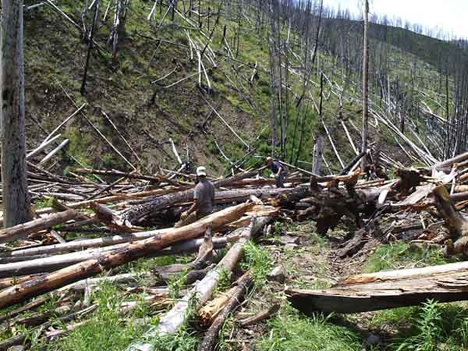
For the News Release, click , <Read more> below.
more »
The Idaho Conflagration League
The 2007 fire season in Idaho was the worst in nearly 100 years. Almost 2 million acres burned, including 800,000 acres in one block stretching across the Salmon Mountains in Central Idaho. More than a quarter of a billion dollars were spent on fire suppression, and 10 times that amount in resource damages were suffered.
Just this month the Idaho Conservation League issued a report calling those fires “natural” and a boon to the state. From Fire in Idaho: Lessons for Human Safety and Forest Health, A Review of Idaho’s 2007 Fire Season, Idaho Conservation League, Written and Prepared by Jonathan Oppenheimer, Senior Conservation Associate, September 2008:
Idaho’s 2007 fire season represented a clear shift in how we manage wildfires. This shift is paying benefits that include better safeguarding of homes, property and human life, as well as wiser use of tax dollars and real benefits on the land. …
These Wildland Fire Use fires carried several benefits. Money that would have been spent fighting them could be directed to more destructive fires. Firefighters were kept out of harm’s way. And dead trees and brush that had built up for years were cleared, making the forest healthier and reducing the odds for a major blow-up in the future.
The Idaho Conservation website is [here]. Their stated goals include ending “commercial logging, roadbuilding, and phosphate mining” in Idaho. Ostensibly they also seek to preserve “Idaho’s clean water, wilderness, and quality of life.” The ICL works to “safeguard communities against agricultural activities that threaten public health and the places we live” and to “defend communities against polluting power generation facilities.”
The ICL is opposed to smoke:
Microscopic bits of material, called particulate matter (PM), are carried up in the smoke and carried by the wind. The by-products may cause health effects such as:
irritated eyes, nose, mouth
increased coughing and wheezing
increased respiratory illness
decreased lung function
possible development of lung diseaseThese inversions cause serious health consequences, especially to those people who suffer from chronic lung diseases including asthma, emphysema, cystic fibrosis, and other types of chronic obstructive pulmonary disease (COPD).
The ICL wants clean streams:
We must also protect the quality of our lakes and rivers as more and more people move here. Streamside areas serve as important habitat for wildlife as well as buffer zones that protect our water and help keep it clean. We must maintain these important areas as a way to preserve clean water and beautiful places that contribute to the excellent quality of life we enjoy as Idahoans.
The destruction by fire of over a million acres of Idaho forests did not yield clean water, clean air, or quality of life. The 2007 megafires that ravaged Idaho’s forests fouled air, polluted streams, destroyed habitat, caused massive erosion, uglified scenery, and degraded the “quality of life” for thousands of residents.
Yet the Idaho Conservation League is blind to that destruction and celebrates the incineration of Idaho’s forests. They call forest holocaust “natural” as if “natural” justifies disaster.
In fact the fires were not natural. They were far outside the historic norms. For thousands of years Idaho has been home to human beings who modified the fire regimes so that mega disasters could not occur. The ICL is in utter denial about that, instead claiming that Idaho was untrammeled wilderness before the white man arrived. The fires of 2007 were larger, hotter, and did far more environmental damage than historical fires.
ICL’s historical/scientific revisionism is quite racist. The paeans to “naturalness” also smack of Luddite sensibilities. The ICL board and staff do not run around naked. They live in wood-framed houses. They eat food grown by agriculturalists. If they get sick they go to medical doctors, not “natural” healers. There is even a MD on their Board.
Proper forest management includes thinning forests so that fires drop to the ground and do not become canopy fire storms. The ICL opposes such treatments. They oppose commercial logging. They favor fire storms because they believe such fires are “natural.”
In their recent report they display a photograph of a 100 percent mortality snag patch, formerly green trees killed by the 2007 fires. The caption reads “Pine needles on the forest floor can significantly reduce erosion after fires.” However, no pine needles can be seen in the photo because they were incinerated.
The erosion caused by the 2007 Idaho fires has been horrendous and is ongoing.
The ICL reported contributions, gifts, and grants in the amount of $1,208,035 in 2006. The recent report was funded by the Wilberforce Foundation [here] and the Wyss Foundation [here]. It is interesting to note that both those foundations are bankrolled by high tech fortunes. Perhaps the wealthy techies feel that incinerating forests in megafires is appropriate penance for their sins of “unnaturalness.”
After all, the type of irrational and flaming hypocrisy demonstrated by the ICL can be described as religious fanaticism. What their religion is, exactly, is less clear.
For future reference, the Board of Directors of the Idaho Conservation League consists of:
Pat Haas (Chair), Boise
Mike Richardson (Vice Chair), Naples
Sharon Steiner (Secretary), Ketchum
Perry Brown (Treasurer), Boise
Matt Bullard, Boise
Claire Casey, Challis
Brad Chilton, Pocatello
Maureen Finnerty, Idaho Falls
Elaine French, Ketchum
Walt Minnick, Boise
Rick Price, Sandpoint
Gayle B. Poorman, Meridian
Janice Simpkin, Twin Falls
Jerry Sturgill, Boise
John Warren, Boise
Michael Wise, Ketchum
Photos of Payette NF and Boise NF Destruction
We posted a letter [here] from Ned Pence, retired District Ranger on the Payette National Forest, reporting on his recent visit to the Krassel District. Over 470,000 acres of the Payette NF burned last year, part of an 800,000 acre holocaust that stretched across central Idaho and three national forests.
Mr. Pence was kind enough to send some photos of the destruction, along with this note:
These are examples of some 200 pictures we took of the results from WFU in 2006 and 2007. Two show the non-maintenance of the former Krassel Ranger Station now a “work center”.
The sedimentation of the South Fork of the Salmon River far exceeds anything that resulted in the logging that Regional Forester Vern Hamre stopped in 1967. If sedimentation from logging damaged spawning habitat for summer run Chinook salmon, the damage from WFU will eliminate the salmon from the SFSR. It will take decades for the sediment to flush out without another catastrophic fire. Please think about the fuel loading that will exist in 20 years when the fire killed timber is on the ground with dog hair regeneration. The second fire will be more intense than the first. Recovery of the SFSR will not occur in my lifetime, probably not in my son’s lifetime.
To allow a lightning fire started in July or August with the current fuel loading is not “natural” or “wise use”. It is abuse. There are better ways of returning to “natural” if that is the objective.
Unfortunately, we must recognize that the Forest Service we loved no longer exists and probably never will. And I feel very bad about that.
Ned
To view the photos click the “Read more” link below.
more »
2007 Fire Season Federal forest policy The 2008 Fire Season
by admin
leave a comment
Are Forests Healthy After Incineration?
“Most scientists and fire managers agree that fire is a healthy and necessary part of the forest,” Rocky Barker, a journalist, not a scientist or a forest manager, Idaho Statesman.
The Leftwing wants to burn Idaho forests to the ground. It’s GOOD for forests according to liberal journalists. Here’s what hopping anti-forest extremists did to Idaho forests last summer, cheered on by the liberal toadies at the Boise Idaho Statesman. Do these forests look HEALTHY to you? For more pics of what the wackos did to 800,000 acres (1,250 sq miles) of central Idaho in 2007, click here, here, and here.
PS — You will NEVER see photos like these in the Idaho Statesman.
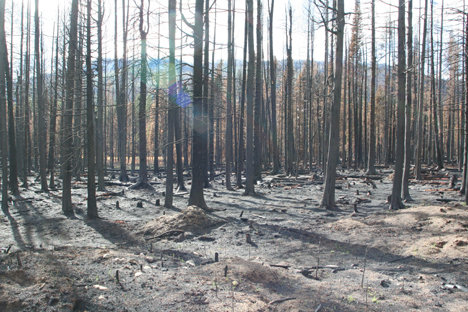
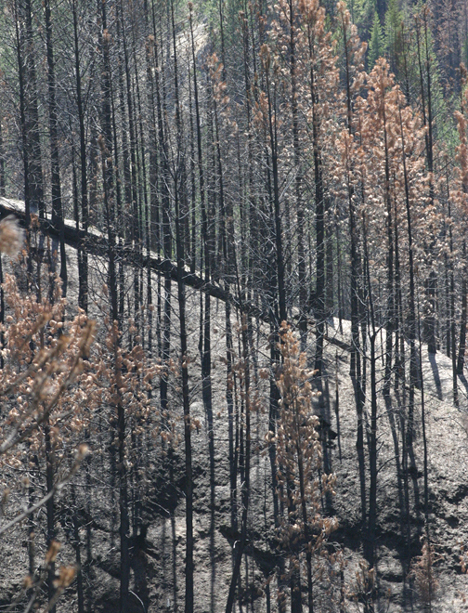


The wood to rebuild Tahoe is sitting there, rotting
The following excellent essay was published last Saturday in the Sacto Bee [here]. We re-post it in full:
By William Wade Keye, professional forester
A year after the Angora fire in South Lake Tahoe, the dead trees, debris and rubble are cleared from the devastated neighborhoods. New homes are sprouting from the earth to the tune of contractors’ blaring rock music, hammers and nail guns.
Lumber to sustain the rhythm is being transported from Canada, Oregon and Washington. Dozens of structures are rising in a cacophony of recovery and new life.
It’s all taking place within the afternoon shadows cast by the thousands of dead trees that remain standing on adjacent national forest lands. Although seared and killed by high heat, inside their charred bark is unburned wood, light and bright.
Yet despite this volume of usable fiber, these cellulose skeletons will never be tapped to help build a single structure.
Rather, the trees killed by the fire will be left to rot, under assault by insects and fungi, as the U.S. Forest Service plans and plans, and then plans some more, about what to do in the aftermath of the last year’s disaster. It doesn’t want to get sued, having lost the will to fight against environmental activists and their attorneys.
Judicial decisions have broken the back of a once-proud federal agency, handing de facto control of the public’s forest to people who don’t like forestry. The wood to rebuild Tahoe is being imported from distant forests hundreds of miles away. This is called protecting the environment.
As an American citizen, I’m troubled that the Toyota Prius was engineered in Japan while Detroit was figuring out how to build a better Hummer. I also don’t understand why we, as Americans, can’t both expand our domestic energy supplies (including fossil fuels and nuclear power) and push for much greater efficiency, alternative sources and new technology.
As a forester, I don’t get the environmental benefit of burning forests down, letting them rot and then – perhaps – trying to clean them up at great expense to taxpayers. I don’t accept that we won’t look to quickly salvage and utilize dead public timber instead of sourcing our wood from living trees in someone else’s backyard, at great cost in terms of wasted energy, carbon emissions and true community. I can’t imagine why we don’t plant trees in denuded areas just as fast as we possibly can to prevent brush encroachment and deforestation.
These behaviors contribute to global warming. A wildfire such as the Angora fire emits massive amounts of greenhouse gases, followed by years of slow methane release. (Methane is 20 times more active as a global warming agent than CO2.) If, instead of allowing dead timber to decompose, we harvest and utilize it in long-lasting products and bioenergy, we can store carbon for long periods and also offset the burning of fossil fuels. Finally, by not reclaiming the site with a growing young forest, we fritter away decades of opportunity to capture and store high levels of atmospheric carbon. This is something that healthy forest ecosystems are remarkably good at doing.
All over the country there is a movement toward locally grown fruits and vegetables, organic foods and community gardens. People are demanding authenticity in terms of what they eat and where it comes from. It helps us make sense of our lives in an increasingly corporate and impersonal world.
In national forest policy, it should be Prius drivers and organic farmers who are leading the way, clamoring for local responsibility and economies of ecological authenticity. Taking wood from distant forests in order to rebuild in Tahoe should be simply unacceptable. Especially when it’s just sitting there, rotting on the stump.
Instead, we accept the grim counsel of the eco-clergy: better to do nothing than risk anything. Burn down the forest, let it go to brush, but just don’t touch it. Where our wood comes from is not important.
No wonder the Forest Service has given up on actively managing its lands, even to the extent of trying to keep them green.
Theodore Roosevelt, who set aside most of our vast system of national forests during his risk-taking years in the White House, is turning over in his grave. Roosevelt intended them to be used, not neglected. Conservation was not about minimizing risk, but about maximizing the social good.
Forestry, like sustainable agriculture, is a “can do” enterprise, as integral to the human experience as rebuilding homes after a terrible catastrophe. When we suppress something so wholesome and engaging, we kill off a bit of ourselves. We become poorer, more afraid, easier to corral into a world of diminished possibilities.
The post-wildfire blight and deforestation in Tahoe, and spreading throughout our national forests in the American West, is a Hummer we are driving, wasting resources and spewing greenhouse gases while new life – and fresh oxygen – is so abundantly available.
William Wade Keye is a California registered professional forester.
2007 Fire Season Federal forest policy Politics and politicians The 2008 Fire Season
by admin
1 comment
Casey At the Bat on Fire
Casey Judd, Business Manager of the Federal Wildland Fire Service Association, gave hard hitting testimony to the Senate Committee on Energy and Natural Resources yesterday. He told them that our federal land management agencies and their fire programs are ill-prepared for the upcoming wildfire season.
Judd discussed three causes: the mass migration of federal wildland firefighters to CAL FIRE and other fire agencies offering better pay, benefits, and working conditions; the diversion of fire preparedness resources to pay for a variety of non-fire programs, positions and projects; and a paucity of hazardous fuel reduction projects.
The full text of Casey Judd’s testimony is [here]. Some excerpts:
This and other committees have been consistently told by the Agencies and “experts” that suppression costs are continuing to rise because of 1) climate/drought and 2) the increasing costs of protecting the Wildland Urban Interface. We, the FWFSA, take serious note with these assumptions. While these two elements are indeed factors, proper preparedness mitigates to a great degree the influence these two elements have on the overall costs of suppression. The question has been posed by both Congress and OMB: If it stands to reason that proper preparedness lead to reduced suppression costs, why after increased preparedness funding under the National Fire Plan, have suppression costs continued to rise? A simple answer – Smoke and Mirrors. …
In February 2006, Agency (USDA) representatives appeared before this committee and once again assured the Committee that adequate preparedness resources would be in place. Firefighters knew this wasn’t going to be the case. The continuation of diverting preparedness dollars resulted in less preparedness resources in the field. The diversion of fuels reduction dollars reduced the number of treated acres. The result was what firefighters expected: reduced preparedness resources allowed many small fires to grow in size, intensity and ultimately cost as either Incident Commanders waited for federal resources that had to now come from much greater distances or, in the typical alternative, the Agency reverted to its over-reliance on significantly higher-priced non-federal resources to fill in the gaps of the missing federal resources. Either way suppression costs increased needlessly. The result was a record year for suppression costs.
Rather than admitting the diversion of funds played a role in less resources being in place and thus ultimately increasing the costs of fires needlessly, the Agency simply reverted to its theory of climate and wildland urban interface as the causes of increased suppression costs.
In 2007 we suggested to Congress that a repeat of 2006 was inevitable. We further predicted as we correctly did in 2006 that the Agency would return to Congress in the fall, complain that it had been a terrible season and seek a supplemental appropriation of another half billion dollars. That is exactly what happened. …
As we enter the 2008 season, the Forest Service fire program, primarily focused in the western United States, and especially in California is imploding. …
Lies, Deceit, Obfuscation, and Destruction
The Wilderness Society is so full of lies. They are destroying America’s forests behind those lies. too. TWS has wormed into the highest branches of the USFS and uses their clout and the public’s money to foment holocaust. It’s not about “wilderness” either. It’s about pure destruction.
One of their operatives, John McCarthy, Idaho Forest Program Director, The Wilderness Society, wrote an excruciating diatribe in praise of holocaust entitled “Idaho Fire Story 2007″. Some quotes:
In another post-Smokey Bear, fire-is-back category Idaho also led the nation in 2007. Idaho saw Wildland Fire Use (WFU), where wildfire runs its natural course for resource benefit, spread across 189,442 acres. And without question the ecological benefits of fire for forest clean-up, nutrient flow and re-structuring were not limited to these WFU lands.
TWS led the “Kill Smokey Bear” and “Blackened, Charred, Dead Forests Are Beautiful” campaigns, with millions of public dollars handed to them in secret, sweetheart contracts by the USFS. The outcomes include the 800,000 acre Yellow Pine Fire [here]. The Yellow Pine Fire is our name for a collage of dozens of fires in 2007 that blackened the Boise, Payette, and Nez Perce National Forests. The Yellow Pine Fire is a complex that includes the Rattlesnake, Raines, Loon, Zena, Profile, Landmark, Monumental, Krassel, and Trapper Ridge Fires, and a few dozen more.
There were no “ecological benefits” from the Yellow Pine Fire, only ecological destruction. Whole watersheds were roasted, and steams fouled with ash and debris.
More 2007 Idaho Fire Aftermath Pics
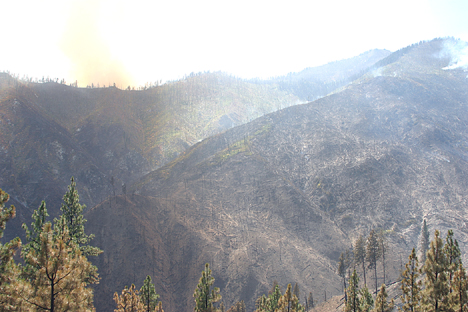
During the 2007 fires. This how to destroy a watershed.
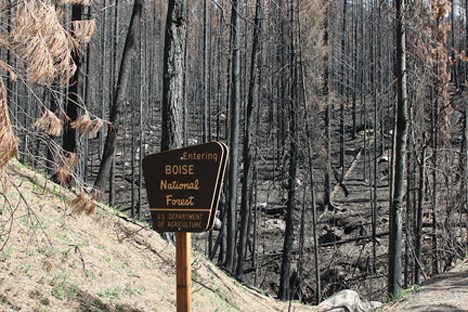
Welcome to the wasteland.
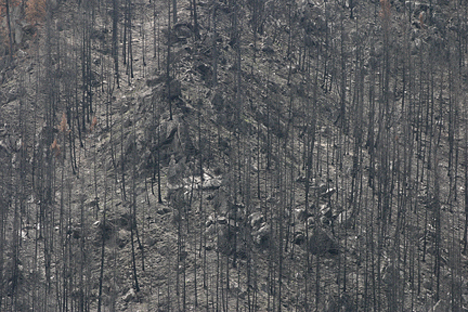
This mountainside used to be green.
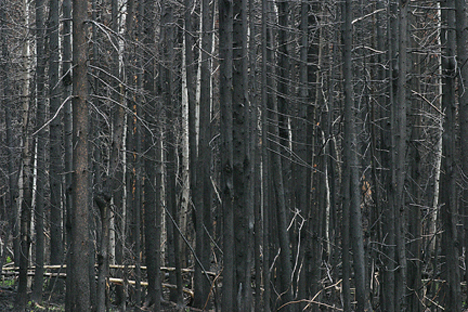
The USFS claims the fires reduced the fuels. Does it look like that to you?
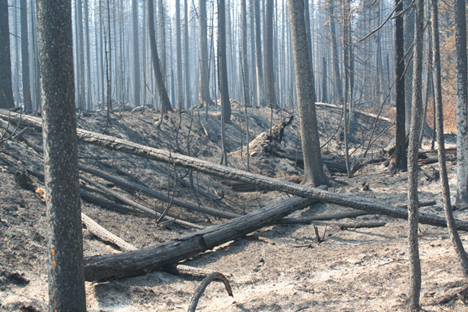
This forest was “treated” by a “wildland fire used for resource benefit.” Is this a healthy forest now? What resources benefited? Answer: none. All imaginable resources from wildlife habitat to watershed values were destroyed utterly.
Do you ever get tired of being lied to by your government? I certainly do.
Some Payette and Boise Pics
Busy today with a variety of projects, so I decided to post a few photos. These are from the Payette and Boise National (former) Forests in Idaho.
Pictures tell a thousand words, so I guess you can draw your own conclusions without my assistance.


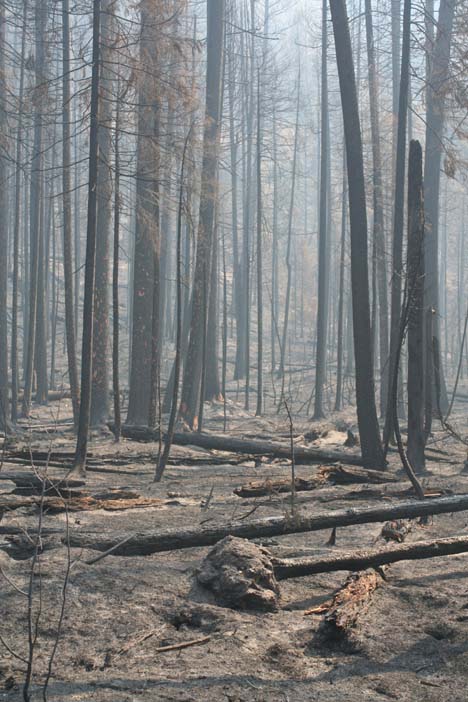

2007 Fire Season Climate and Weather Forestry education Saving Forests
by admin
3 comments
Half of All Oregon GHG Emissions Come From Forest Fires
Half of all Oregon greenhouse gas emissions in 2007 came from forest fires. This information was revealed Thursday, May 15, at a Department of Environmental Quality (DEQ) meeting in Portland.
The meeting was a public hearing held to gather comments regarding Governor Kulongoski’s proposed Greenhouse Gas Mandatory Reporting Rules now under consideration by the Environmental Quality Commission (EQC), the board that oversees the DEQ.
The DEQ began the meeting by presenting a pie chart and a graph that indicated total GHG emissions in 2005 were 62 million tons (U.S.). The pie chart broke those emissions down by the following sectors: Transportation (34%), Waste (3%), Residential (17%), Commercial (14%), Industrial (25%), and Agriculture (14%). No forest sector was listed.
Then Mike Dubrasich, Executive Director of the Western Institute for Study of the Environment headquartered in Lebanon, OR, presented an analysis of GHG emissions from forest fires. According to Mr. Dubrasich (that’s me), in 2007 approximately 56 teragrams of GHG’s (principally CO2) were emitted by the 750,000 mostly forested acres burned last year in the state. One teragram equals 1.1023 millions tons (U.S.), so after conversion 61.7 million tons of GHGs are estimated to have been released by fires.
Mr. Dubrasich (me) told the DEQ, “You are missing an entire pie!”
more »
